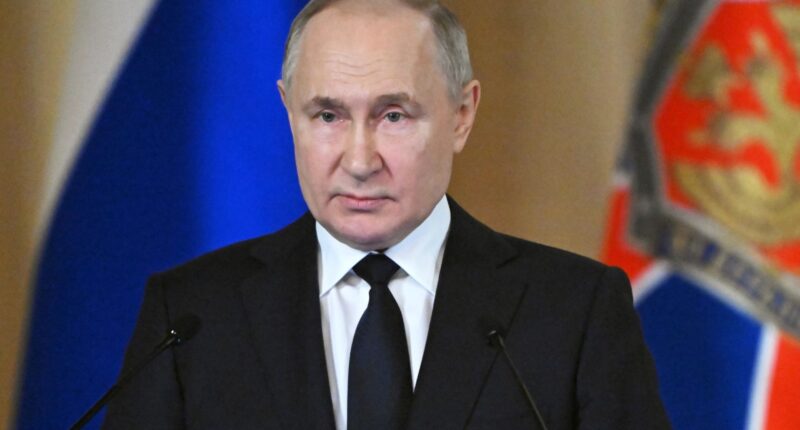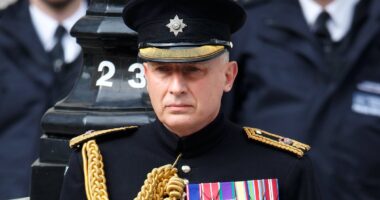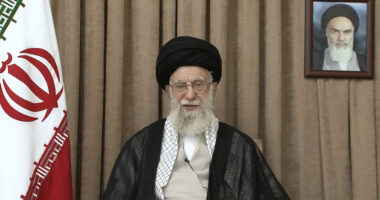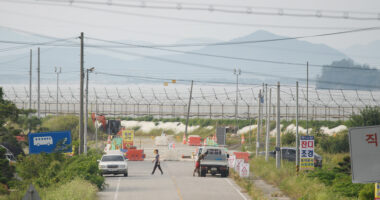THE West can crush Russia’s war machine and force Putin to the negotiating table with a Cold War-style strategy, a former Nato adviser has warned.
Ian Brzezinski, a former deputy assistant US Secretary of Defense for Europe and Nato policy, believes that Moscow can be defeated in Ukraine. However, he emphasizes that this can only happen if the West effectively utilizes its economic and military power.




Instead of seeking a negotiated settlement, he says the focus should be on overwhelming Russia’s capacity to continue the war.
According to Brzezinski, the Russians are likely to prolong the conflict and possess the capability to sustain it for an extended period. Despite this, he remains confident that Russia can be overcome in this conflict.
“And to do that doesn’t mean that one should run to Russia asking for a deal to end the war. One has to get into the Soviet mindset.”
Brzezinski points out that Putin’s perspective is still influenced by a Cold War mindset. He suggests that the key to compelling Putin to negotiate is by significantly altering the balance of power to a point where he has no option but to pursue a peaceful resolution.
This strategy echoes the high-stakes power plays of the 20th century, where military posturing and economic pressure dictated geopolitical outcomes.
To accelerate that breaking point, Brzezinski argues, the West must apply the same tactics that helped undermine the Soviet Union.
That includes ramping up military support for Ukraine, tightening the economic stranglehold on Russia, and launching an aggressive information campaign targeting Moscow’s political elite.
The goal is to force Putin to focus inward, worrying more about his own survival than his expansionist ambitions.
During the Cold War, the West used economic warfare to weaken the USSR, restricting trade, limiting technology access, and driving down oil prices to cripple its economy.
A military arms race forced the Soviets into unsustainable defence spending, with initiatives like Reagan’s “Star Wars” straining their resources.
Psychological and information warfare fuelled internal dissent – Radio Free Europe, underground publications, and support for dissident movements helped destabilise Soviet control.
The expert argues that similar tactics – tightening sanctions, ramping up military aid to Ukraine, and using modern propaganda to undermine Putin’s grip – could force Russia into economic and political exhaustion, just as the USSR collapsed.
The ex-Nato adviser, now a member of the Atlantic Council’s Strategic Advisors Group, has spent decades shaping defence policy.
In the early 1990s, he advised Ukraine’s National Security Council, Foreign Ministry, and Parliament.
He also worked on NATO strategy at the Pentagon and served as a consultant for the Center for Naval Analysis.
His father, Zbigniew Brzezinski, was one of America’s most influential Cold War strategists – serving as National Security Advisor to President Jimmy Carter and playing a key role in countering Soviet influence.
Now, as history repeats itself, Brzezinski believes only a return to Cold War tactics can finally bring Putin to his knees.



‘Body slam Russia’s economy’
The numbers alone paint a stark picture.
The Nato alliance boasts a GDP of around $54trillion – more than 25 times Russia’s estimated $2trillion, which remains heavily dependent on energy exports.
Nato defence spending, currently rising, is already ten times Russia’s estimated $120-$150billion annual military budget.
Despite this overwhelming advantage, Brzezinski said the West has so far failed to exercise its full power to end the war on Ukraine’s terms – and is yet to deliver a true knockout to Putin’s economy and war machine.
“We have yet to really body slam the Russian economy. We can do that,” Brzezinski said.
“We haven’t, and this allows the Russian war machine to drive forward.”
Despite Moscow’s resilience, cracks in its war economy are beginning to show.
Western sanctions have severely limited Russia’s access to critical technologies – forcing it to rely on outdated Soviet-era stockpiles and imports from countries like Iran and North Korea.
And domestic industries are struggling as hundreds of thousands of young men have either been drafted into the military or fled the country to avoid conscription.

Oil and gas revenues – the backbone of Russia’s economy – have also taken a hit.
While Moscow has successfully redirected exports to China and India, these buyers demand steep discounts – significantly reducing the Kremlin’s war chest.
The long-term sustainability of Russia’s wartime economy remains in question – especially if the West tightens restrictions and closes loopholes in sanctions enforcement.
Brzezinski believes a more aggressive approach – such as cutting off all access to Western financial systems and targeting Russia’s energy revenue streams – could force Moscow into a crisis it cannot survive.
Another key factor is undermining Putin at home by engaging the Russian people.
We have yet to really body slam the Russian economy – we can do that
Ian Brzezinski
The war remains a state-controlled narrative inside Russia, with independent media suppressed and opposition figures jailed or exiled.
But history shows that public discontent can reach a breaking point – especially when economic hardship begins to bite.
Encouraging internal dissent and turning public sentiment against the war – or even against Putin himself – could erode his grip on power.
“A real effort to engage the Russian people, to help turn them against this war, if not against Putin himself,” Brzezinski said.
And perhaps the most decisive step is fast-tracking Ukraine into Nato.
The debate over Ukraine’s NATO membership remains contentious.
Some Western leaders fear that immediate accession could escalate the war into a direct NATO-Russia conflict.
Germany and France, for instance, have been more cautious about escalating military aid, fearing potential Russian retaliation or economic repercussions.
As long as Putin’s in office, I find it very difficult for Ukraine to have a peaceful relationship with Russia
Ian Brzezinski
US Congress has also been divided on further funding for Ukraine – with some lawmakers arguing Washington should focus on domestic priorities instead.
Others argue that delaying membership only emboldens Putin by keeping Ukraine exposed.
Either way, Brzezinski sees no lasting security for Ukraine outside the alliance.
He explained: “That is probably the only thing that will convince Putin that Ukraine is no longer in the grey zone, vulnerable to his ambitions.”
Inside Trump’s plan for peace
DONALD Trump’s top team has hatched a carrot and stick plan to force the warring leaders to the discussion table and bring peace to the region when he enters office in January.
The clever scheme uses America’s military support for Ukraine as a double-edged sword to encourage Zelensky and threaten panicky Putin.
If the Russian war-mongering kept snatching land and refused to join peace talks, Trump would make him suffer by pouring more cash into Ukraine’s military.
Zelensky would be rewarded for following Trump’s lead with support for Ukraine to protect itself under the new terms of any deal.
Under Trump’s plan, Zelensky would have to give up the land Russia has already taken in the eastern regions of Ukraine and drop his dream of immediately joining Nato.
The Ukrainian leader has repeatedly ruled out land sacrifices for most of the war but recently indicated he might consider the option to halt the bloodshed.
If Zelensky did not cooperate, Trump would slash the US support that the Ukrainian military relies on.
There are signs both Zelensky and Putin may fall in line with Trump’s plan which could prove to be a silver bullet.
Insiders close to Trump told The Sun that Putin is “scared to death” of the president-elect and will be ready to talk when he takes power.
But bullish Vlad is already teeing up hard-line terms for any deal brokered by Trump, sources say.
Zelensky indicated he may be open to negotiations, but still has Ukraine joining Nato as part of his “victory plan”.
There is consensus among Trump’s advisors that any peace deal would rule out Ukraine joining Nato in the near future, so this could be a sticking point.
But this is where the US could use the threat of withdrawing military support to leverage Zelensky.
No ‘real peace’
Even if a ceasefire is reached, lasting peace between Russia and Ukraine is unlikely for generations.
The brutality of Russia’s invasion, Brzezinski argues, has created wounds too deep to heal anytime soon.
“That’s a consequence of the savagery and the butchery that the Russians have executed on Russian territory against Ukrainians,” he said.
“Certainly as long as Putin’s in office, I find it very difficult for Ukraine to have a peaceful relationship with Russia.”
Instead, the best-case scenario may be a prolonged but stable confrontation – similar to the Cold War, where direct conflict was avoided, but tensions remained high.
Coup in the Kremlin?
A power struggle inside Russia remains a possibility, according to the former Nato adviser.
“We saw what happened a year and a half ago, with the Wagner Group rebellion that occurred,” he said.
“But my sense is that Putin’s got a very firm grip on Russia.”
Yet authoritarian regimes, no matter how strong they appear, often prove brittle when they finally break.
And change could come suddenly and violently.
“There is a breaking point, and when it happens, it usually happens very quickly and very savagely,” he warned.
Trump’s Ukraine gamble
Brzezinski also weighed in on Donald Trump’s stance on the Ukraine war, noting a shift since his reelection.
During his campaign, Trump downplayed the invasion as a European problem rather than a US concern.
He also raised fears that the war could spiral into a nuclear conflict.
His rhetoric at the time alarmed European allies, who feared a US pullback would leave Ukraine dangerously exposed.
But since returning to office, Trump seems to have taken a sharper turn against Moscow.
“He’s calling Russia an adversary. He has said that he is not going to abandon Ukraine,” Brzezinski noted.
“He has warned Russia that if it doesn’t stop this war and come to the negotiating table, he’ll impose strong tariffs.”
While still wary, he sees signs that Trump’s approach may be evolving.
“There are some signals that there may be a rethinking in his approach,” Brzezinski added.
“I’m still a bit concerned, but watching with a certain amount of hope.”

















